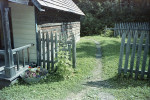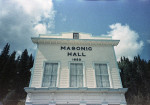May
20
2016

Sometimes what you need is a little extra width and when it comes to film point and shoot cameras there is nothing like the Pentax 24EW. The Ricoh Gr21 has a wider focal length but does not zoom the Ricoh R1 goes to 24mm but only in its panoramic mode (It can be forcibly made to cover the full frame but at a visible cost in image quality). There is the Vivitar Ultra Wide and Slim but it falls more into the toy camera category. So when it comes time to shoot wide angle with a little versatility this is the camera. Some of the features I’ve gone over previously but are worth mentioning again are: exposure compensation of +-3EV in half stops, spot AF, Macro shooting at 0.3m in wide and 0.5m at telephoto.
The 24-105mm lens is built using 7 elements in 5 groups with apertures of f4.9-12.8 and for that reason it really needs quite a bit of light or fast film to be its most useful.
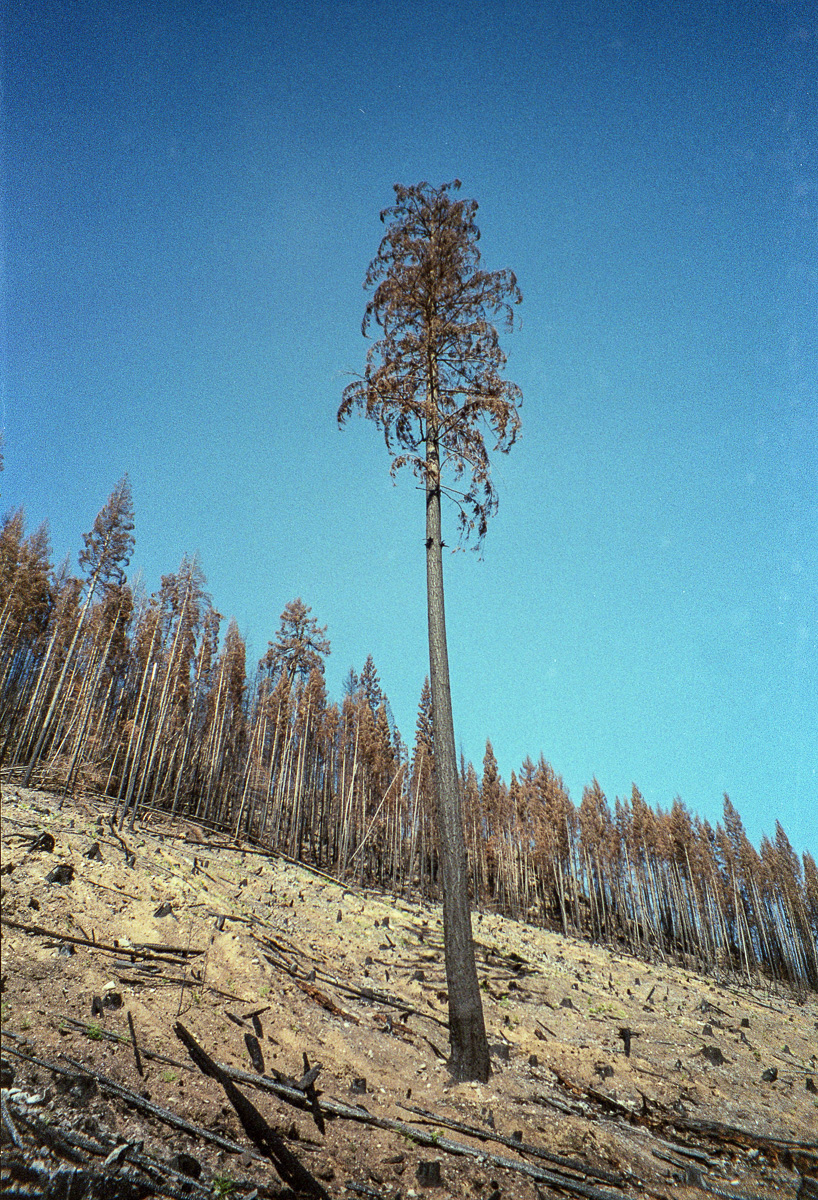
It’s easily seen even in these small versions of the images that there is a lot of distortion in the corners with the 24EW but at least you are able to record them. In the center of the image it performs as well as most film point and shoot zoom cameras good but never great. I used Kodak 400 film a speed of film that I would recommend as there is no real advantage to using slower film for finer grain this lens just isn’t up to it.
no comments | posted in Cameras, Photography
May
12
2016
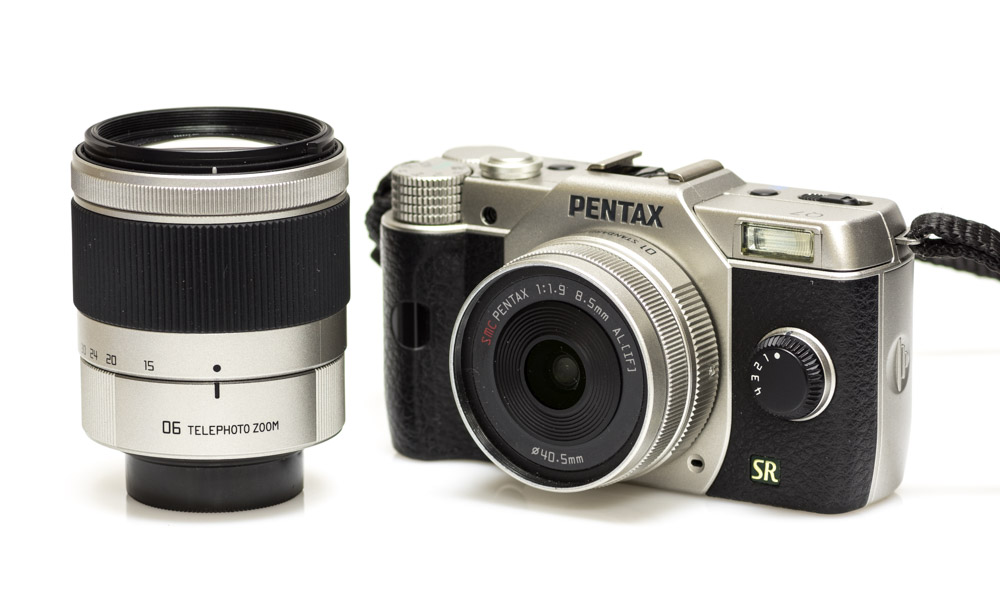
Its difficult to talk about a lens for the Q series of cameras without also talking about the cameras. Even though the lenses are interchangeable, more than any other camera system the two are intrinsically linked. What I mean is that you really can’t talk about one without the other. So while the 06 telephoto is equivalent to a 70-210mm lens on a 35mm format camera it really isn’t the same thing.
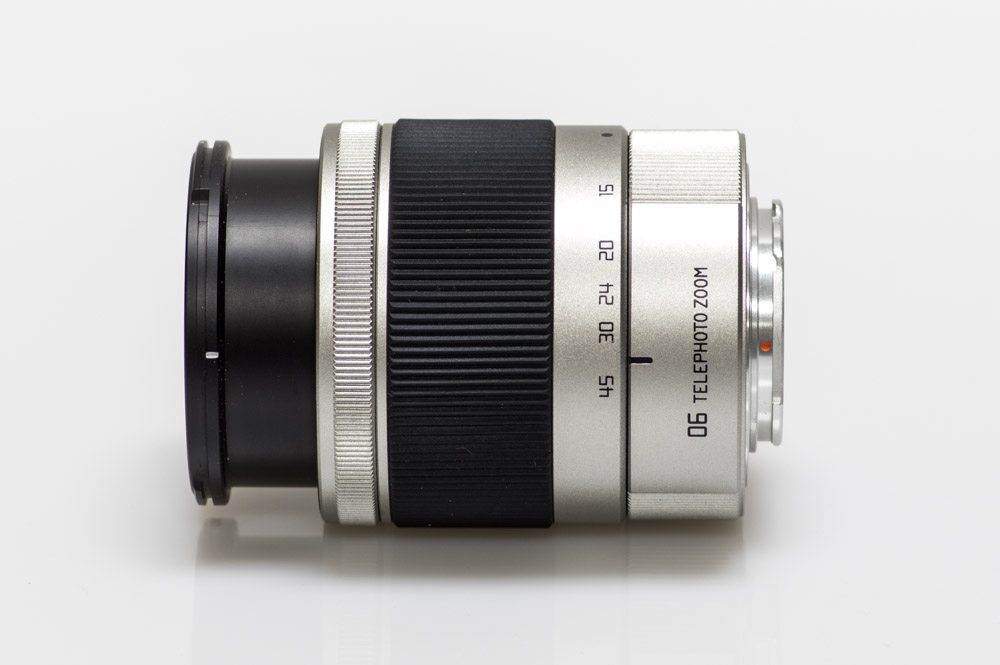
The sensor on the Q7 is tiny and that has drawbacks and advantages. The drawbacks are around noise and a very large depth of field. Using the 06 addresses those issues somewhat by being relatively fast at f2.8 across its entire zoom range and also with the longer focal lengths it is possible to isolate a subject against the background. The small sensor also allows for the lens to be built incredibly small, in fact it only weighs 90g
 45mm f2.8
45mm f2.8
The lens renders the out of focus areas in a nice smooth way leaving the point of interest to stand out effectively. The ability to focus closely is limited though at 100 cm throughout the zoom range which places limits on how large you can reproduce an item, it is no macro lens. Also on the detrimental side of things the small sensor of the Q is prone to purple fringing and moire, the former can be mitigated in editing but high contrast areas can be challenging and can require a little editing or profiling. Also there is a tiny amount of chromatic aberration that also requires addressing to achieve the best results. This despite the fact that the lens is built with 14 elements in 10 groups.  45mm f3.2
45mm f3.2
Of course you don’t always want a shallow depth of field and for that the Q and its lenses excel. Also stopping down can improve the image quite a bit particularly for distant details.

So once you consider the limitations and if you work within the abilities of the combination you can get pretty good results and when you also consider just how small it all is the 06 zoom is a great little lens worth having for anyone with a Pentax Q series camera.

29.7mm f4
The Pentax Q 06 Telephoto does provide excellent sharpness across the entire frame as seen above, you can click trough to a full resolution version of this file.
One final note this lens as well as the 01 prime and 02 zoom all have a 40.5mm filter size so can share filters and also lens caps. You can just grab any one from your bag as your changing lenses.
3 comments | posted in Cameras, Photography
May
5
2016

There is something very satisfying about seeing a scene projected onto the ground glass of a twin lens reflex camera and the great thing about the Yashica 44 is its so small it easy to pack around. I’ve written previously on how to convert one to use 35mm film Yashica 44 35mm conversion. One tip though use film that lays flat on its own like this Agfa Vista I used this time around, do not use expired Kodak consumer film, Ektar would be fine but anything with a tendency to curl will drive you to distraction when it comes time to scan it. There is also a satisfaction derived from shooting through the sprocket holes and over the films edges with its unique look.
no comments | posted in Cameras, Photography
Apr
28
2016

This post is more about the film than the camera (Other Posts about the A-1 can be seen here). I came into possession of two rolls of Ferrania Solaris via a thrift store. I don’t know the age of it but it has to be outdated simply for the fact that Ferrania isn’t currently making film and haven’t for a while. They are at this time making an effort to restart production in a new smaller plant Film Ferrania. I didn’t hold out that much hope for this film with its unknown provenance but unlike so many of my odd film experiences this exceeded my expectations it has a graininess to it similar to but more subtle than Adox color implosion while keeping the colours more realistic.

It ended up being quite contrasty but still retained details in the darks unlike many other outdated films I’ve encountered. I shot this roll on a drab dark day so maybe I will wait for a nice bright spring day to shoot the second roll. I wish Ferrania much success with getting their plant up and running whether they ever produce Solaris again or not.
no comments | posted in Cameras, Photography, Processing
Apr
17
2016

The Ricoh R1 is much like two cameras in one as I’ve stated previously. The 30mm lens is a fantastic performer and the 24mm panoramic has a toy camera aesthetic. The decision to use Adox color implosion film is more in keeping with the latter but I like the unmistakable ‘filmness’ either way. The gallery that follows is a little of each and for the moment it ‘s the 24mm panoramic film camera I use as my Minolta Freedom Vista was stolen from my vehicle. I suppose the joke is somewhat on them as there isn’t a big market for film cameras let alone ones that only take panoramic shots. It’s more likely to end up in a dumpster than to take another picture but I hope it does get used even if it isn’t by me. In the meantime the R1 is one of the best point and shoots I have so I turn to it often.
1 comment | tags: adox, color implosion, film, panoramic, Ricoh | posted in Cameras, Photography
Apr
9
2016

The Konica AF3 and this one with the date stamp the AF3D marked the end of the 16 year run for the Konica C35 and its variations. From 1967 to 1983 Konica had produced many models adding improvements and features along the way but always with a fixed focal length lens. This final version had a 35mm f2.8 lens of 4 elements and autofocus. It’s a great lens despite my gallery images but the camera itself is less than inspiring. It was made available in other colours perhaps that’s what it needs. The fact that Konica did not include a film advance motor but it still has a film advance lever is a nice touch as it makes the camera very quiet to operate. You manually set the film speed but it is a limited range of 100-400 ASA so 200 speed film is probably the best allowing for +- 1 stop of adjustment as needed by overriding this setting.
This is perhaps the worst roll of expired film I have ever come across it is or was Kodak Max 400. The other roll of film in the tank did not have any issues and the camera is unlikely to have caused this so the film is the only culprit left. The images were well enough received on Instagram with some people likely wondering what filter I had used.
no comments | posted in Cameras, Photography
Apr
4
2016
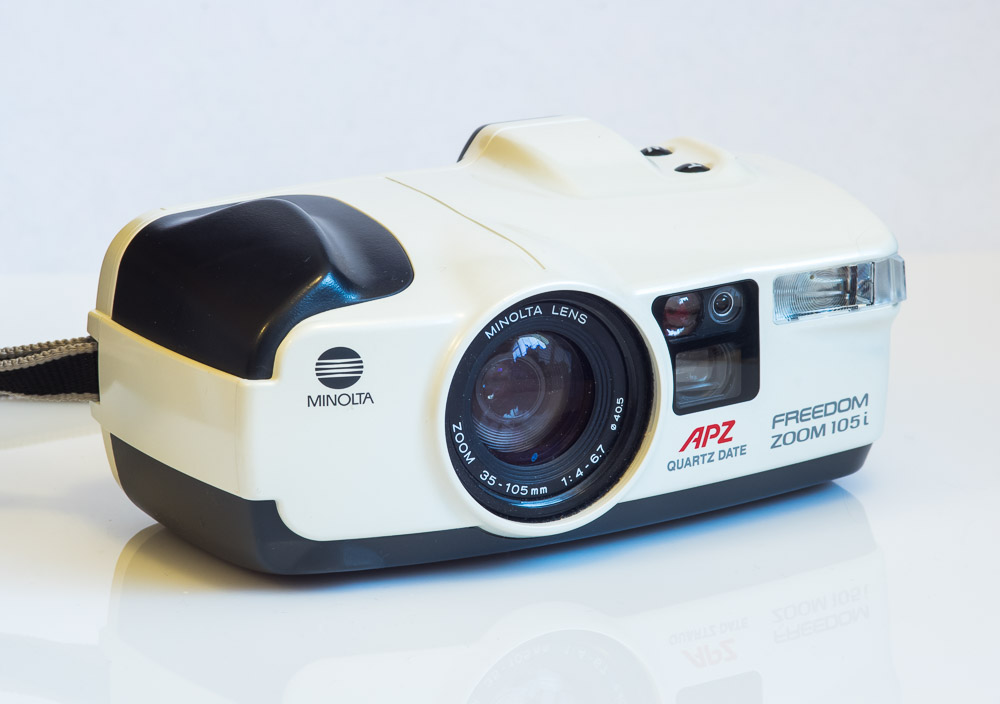
Only from the mind of Minolta, that was a marketing tag line used by the camera maker to denote the leading edge technological aspects of their gear. In the case of the Freedom Zoom 105i though only from the mind of the marketing department. This feature could only have been dreamed up by a non photographer trying to make their product stand out. It has to be one of the most ill conceived features ever added to a camera. What is it exactly, you may be wondering considering that you probably have never seen one of these cameras and may not ever. It is an automatic zoom feature, (Advanced Program Zoom), and depending on the distance to the subject as determined by the autofocus system it will zoom in or out. Minolta says the camera suggests composition. Trying to use the camera I found myself in a constant battle. You see a nice sweeping landscape and want to take a wide shot, oh no you don’t the camera insists that you zoom in. You want to zoom in and isolate a subject, oh no you don’t the camera knows better. All that wouldn’t matter so much if it stopped once you tried to make an adjustment but it continues to zoom around. The only solution aside from hurling the camera at a solid object is to override the system by holding down both zoom buttons at the same time… Every time you turn the thing on. A T.V. ad from around 1990 suggests that it has a mind of its own making it easy for anyone to take a picture, only from the mind of Minolta.
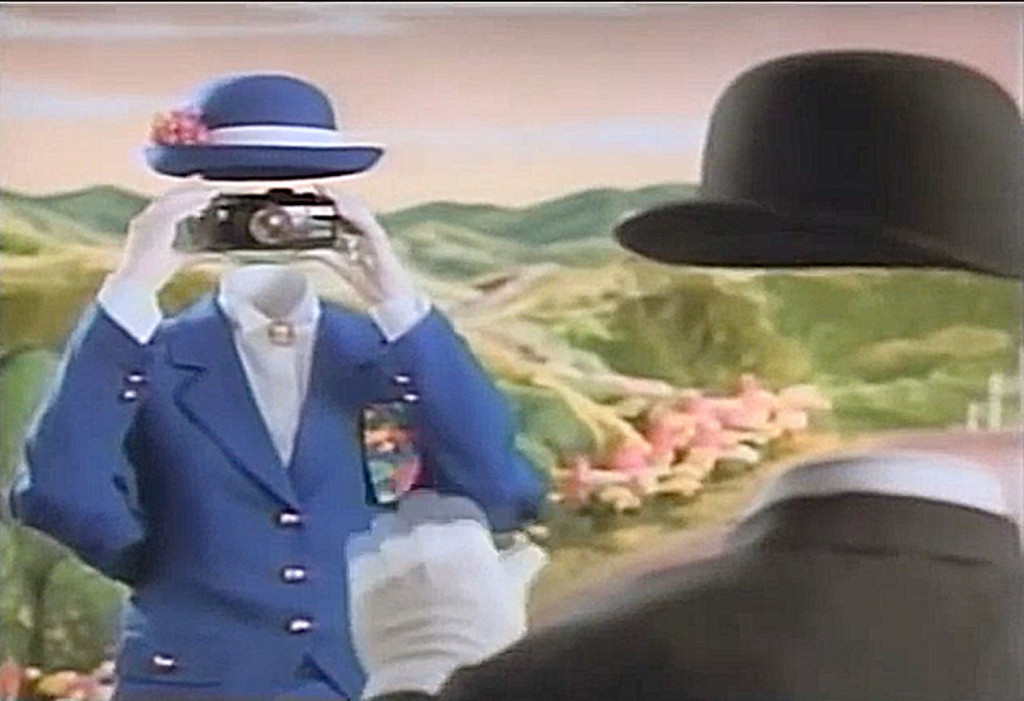
The camera is also larger than necessary given that it only has a 35-105mm f4-6.7 zoom. It looks more like it belongs as a monocular vision system for a storm trooper in Star Wars. To be fair though ergonomically its actually pretty good and is perhaps the easiest camera to hold steady that I have ever encountered thanks to the natural way your hands fit. If only it didn’t battle you for composition supremacy.
2 comments | posted in Cameras, Photography
Mar
30
2016
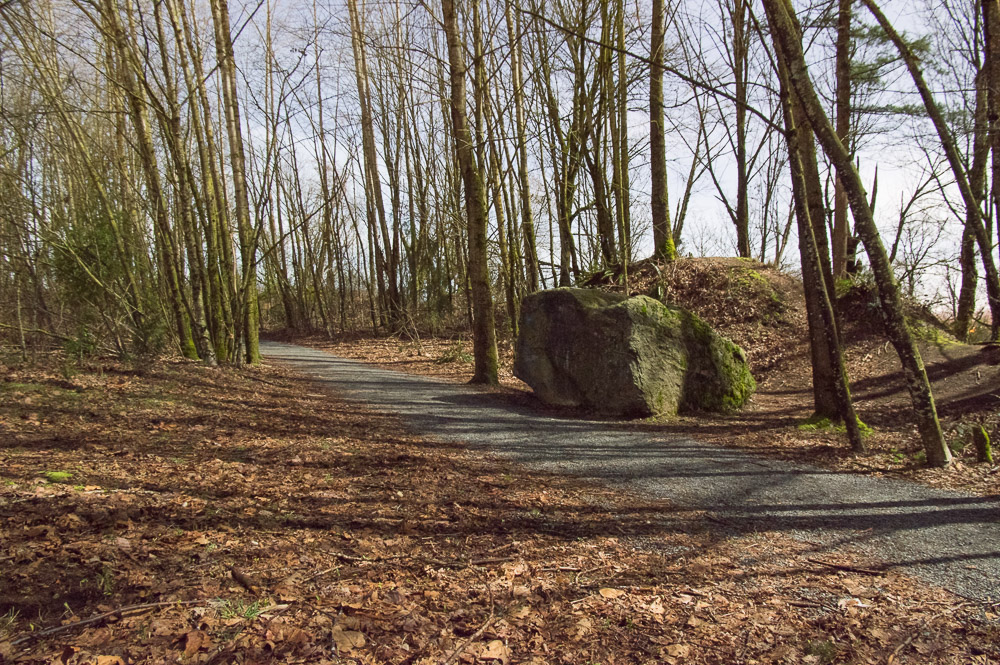
Image created in camera by moonlight using 4 30second exposures
One of the restrictions of many DSLR cameras is the limit of the longest exposure you can set is 30 seconds. This forces you to use bulb mode and a separate method of timing the exposure. There is an alternative though with newer Pentax cameras such as the K-3, K-3II and recently announced K-1. The way it is achieved is by changing the drive mode to interval composite. When set to this mode you also want to set the combining to additive so that all the exposures are summed together into one file. 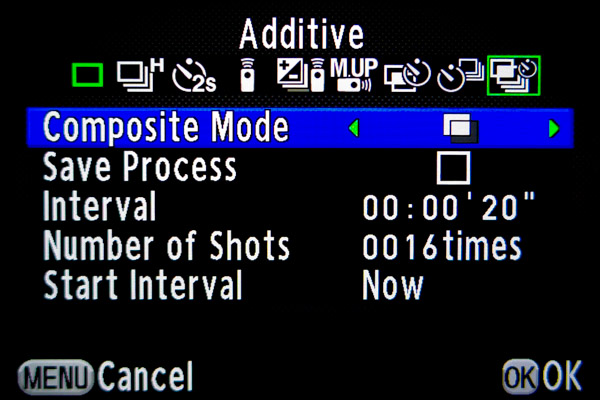
Next select an interval that is larger than the length of the exposure (This is a necessary setting). So if your going to use the 30 second maximum set this to around 33 seconds as that allows enough time for the exposure and processing of the file. After that it’s just a matter of selecting how many exposures or in this case how many times 30 seconds. For example 4 exposures would equal 2 minutes, 20 would result in a total of 10 minutes. There is a drawback and that is the necessary short gap between exposures. If there is something moving in a predictable way such as a star it’s going to leave a small gap where it isn’t recorded.
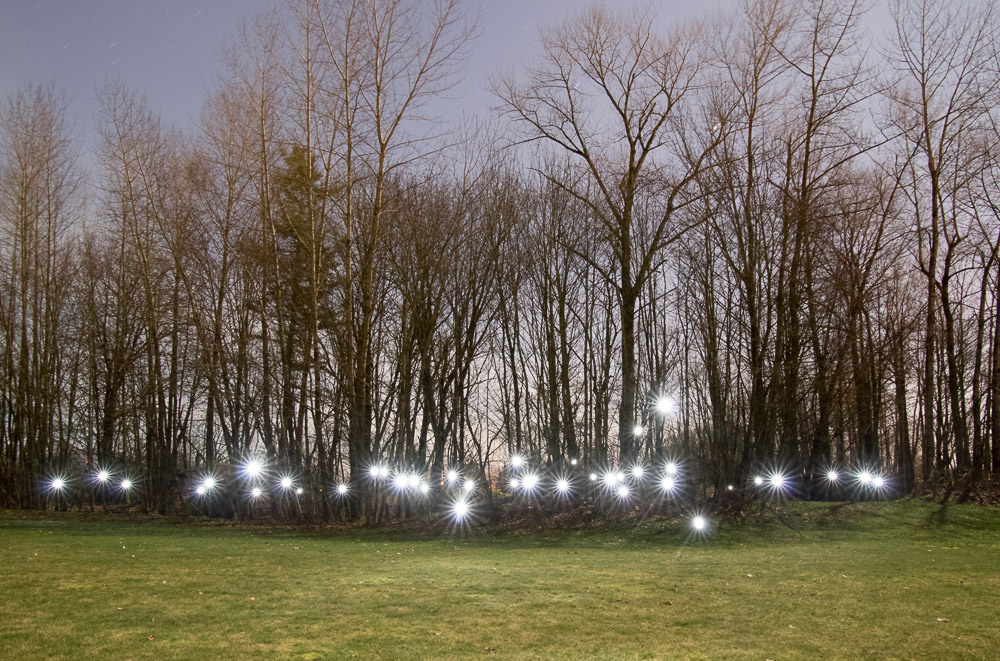
Here the multiple exposures have given my time to walk around in the scene and manual trigger a flash
Of course you can also use a shutter release cable in bulb mode and lock it down I just wanted to present an alternative method that is more automatic and controllable
Back before digital there really was only one way to create star trail images and that was to use a very long exposure and some trial and error. You can still do this but digital sensors behave differently than film over long periods and digital noise can become an issue. Some people have used a different method where they capture multiple images over a period of time perhaps hundreds of them and then stack them using computer software. The new Pentax K-1 apparently has a new composition mode that facilitates doing this in camera referred to as star streams (It turns out that that feature is actually a method of creating 4K time-lapse movies where the star trail ends fade out after a period of time, it will be interesting to see) but I wanted to share how you can do it now with the K-3 or K-3II
You still use the image composite drive mode but rather than setting the combining to ‘additive’ you want to set it to ‘bright’
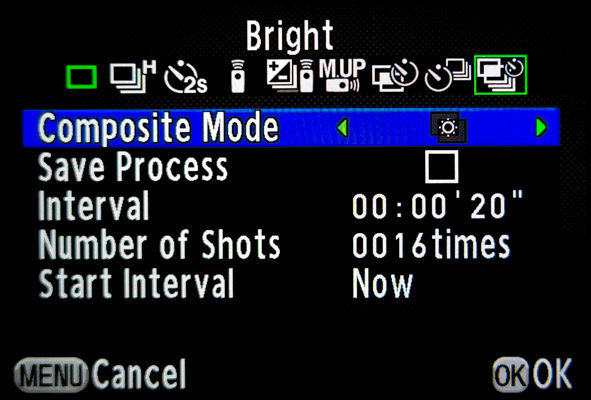
This way bright objects such as stars will be added to the exposure while darker things such as a foreground will be left dark. This is different from a long exposure because of the way the frames are combined and is most easily illustrated. The following pictures where both taken with settings of ISO 1600 f5.6 120 Seconds. The one on the left with bulb mode and the one on the right by combining 8 15 second exposures.
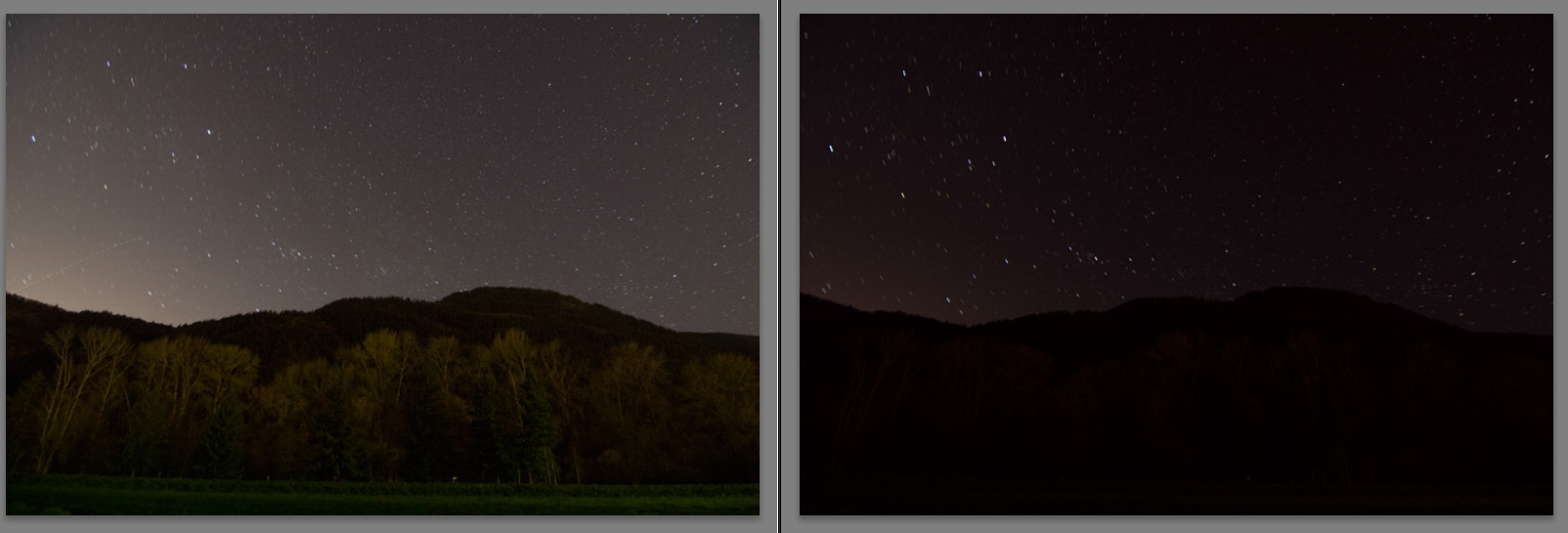
While not long enough to really show the star trails yet you can see that the accumulation of light pollution and noise is having an adverse effect on the long exposure more than the composite image. Also at some point continuing on in bulb mode the foreground would become over exposed.
In this next image I’ve stepped it up to 18 exposures of 20 seconds for a total of 6 minutes which is still too short a time to create a dramatic image but this can easily be extended further by just adjusting the number of images to be ‘stacked’

If I get a clear night in the near future I will update this with a longer capture. The point though is that there are tools built into these cameras that are waiting for creative exploration. As a side note the image that is generated can be a RAW file and tends to have less noise due to the combining of the images. Also generating images in this way doesn’t require dark frame subtraction and the time penalty that entails. Although the dark frame count down timer on the top LCD is a nice touch its like waiting for water to boil and is lost time. And of course you aren’t burdened with dealing with a whole pile of files on your card and in your computer which is a very film like notion.
5 comments | tags: Digital, long exposure, Pentax, star trails | posted in Cameras, Photography, Uncategorized
Mar
28
2016

The Minolta 7s rangefinder has a bright 45mm f1.8 lens built with 6 elements. While it has an electronic shutter I much prefer to use it in full manual operation where a 1.35V battery isn’t even required. That being said the aperture and shutter speed are set using two narrow rings on the lens barrel. They are adjacent to each other so care needs to be taken when changing the exposure. The side benefit of this arrangement and its reason is so that you can change both values in step keeping the same exposure while changing the shutter speed and aperture much like a modern Program mode. The shutter on the Himatic 7s sounds like it’s capable of chopping vegetables but they also appear to be extremely reliable ( I do not recall coming across any of these cameras with a stuck shutter). The viewfinder is bright and large and the framing lines move with focus to adjust for parallax. The one big knock on the Himatic 7s is its size and weight it’s a beast weighing in at 720grams and a full inch wider than a Himatic E or F. When you read out something like an inch wider it doesn’t sound like that much but in practice that is a huge difference.
For this roll of Kodak 800 I pushed the limits of this camera, shooting a series of nocturnes under very low levels of illumination. The shutter only goes down to 1/4 of a second but even at this speed some form of support is required to limit the amount of blur induced. Again shooting in manual mode allows full control over exposure and really I’m not confident that the light meter of this or any camera from 1966 can deal with this low a light level.
For some daylight photography and a better idea of what this camera can produce Minolta Himatic 7s
3 comments | posted in Cameras, Photography
Mar
24
2016
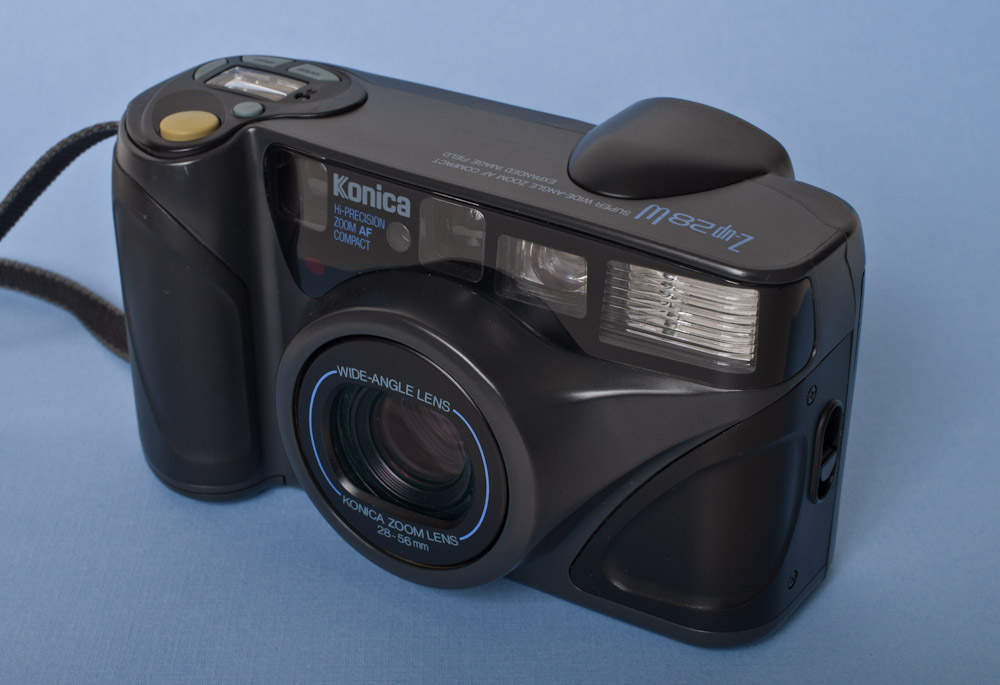 The Konica Z-Up 28W is a large camera considering it only provides a 2X zoom lens but it is one of the better point and shoot cameras that provide a 28mm focal length. I’ve written previously about it here Konica Zup28W and here Konica Zup28 Kodak 400
The Konica Z-Up 28W is a large camera considering it only provides a 2X zoom lens but it is one of the better point and shoot cameras that provide a 28mm focal length. I’ve written previously about it here Konica Zup28W and here Konica Zup28 Kodak 400
no comments | posted in Cameras, Photography



















































































